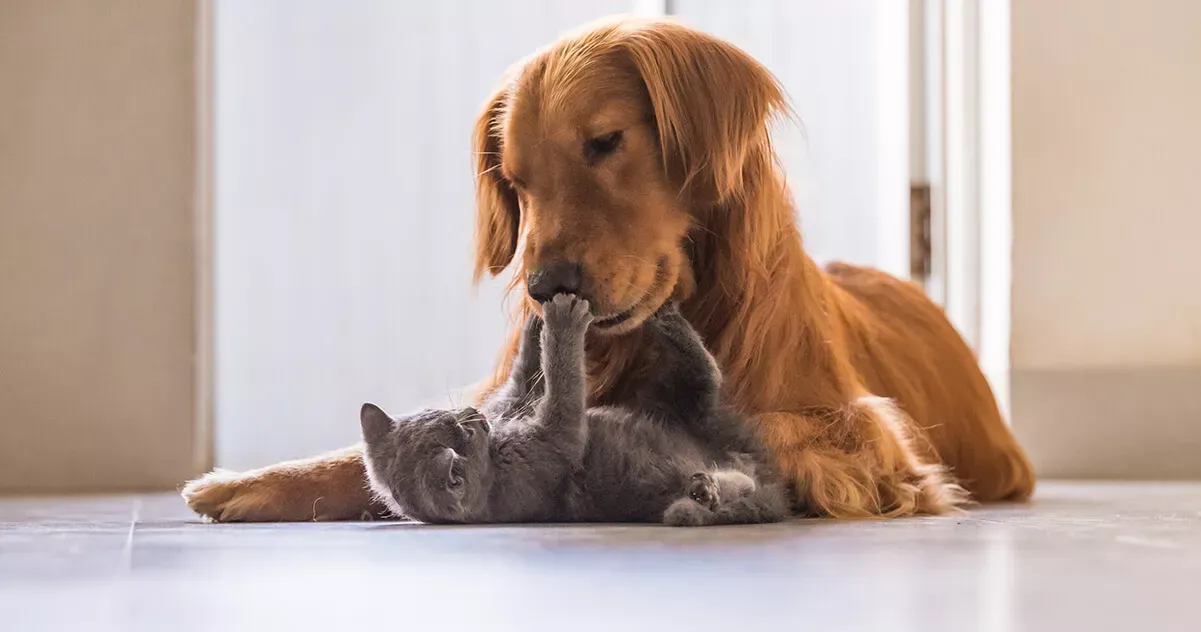Bringing a cat and dog into the same home can be rewarding, but understanding whether your cat and dog are playing or fighting is crucial for their safety and harmony. Misreading their interactions can lead to stress, injuries, or lasting tension. As pet owners, we often anthropomorphize their behaviors, but cats and dogs communicate differently through body language. For instance, a high tail signals relaxation in cats but alertness or aggression in dogs. Recognizing these subtle cues helps ensure peaceful coexistence.
Dogs are pack-oriented and expressive, wagging tails to show joy, while cats are more independent, twitching tails indicating irritation. Ears back on a dog might mean friendliness, but forward ears on a cat show engagement. Side-turning calms dogs but can make cats appear threatening. Mastering these signals prevents misunderstandings and fosters a happy multi-pet household.
 Cat playing with dog.
Cat playing with dog.
Signs Your Cat and Dog Are Playing or Fighting
Never leave your cat and dog unsupervised for extended periods, especially early on. Cats can escape to high shelves or curtains, but dogs lack such options if a cat turns defensive. Positive signs include the cat tolerating licks or grooming from the dog, indicating tolerance and bonding.
However, warnings appear if the cat paws the dog or backs away—these are “enough” signals. Dogs mouthing gently, like with littermates, aim for play, but cats may flee in fear. Intervene promptly to prevent accidental bites. Conversely, cat claws out can scratch the dog, provoking retaliation. Separate them immediately if claws emerge.
Chasing stresses cats, leading them to hide; isolate the dog until the cat reappears, then reintroduce supervised. Growling or hissing demands instant separation—play doesn’t involve these vocalizations. Safe play features no escape attempts, retracted claws, and soft mouthing without teeth. Monitor sessions to 5 minutes max; short, positive interactions build trust without escalation.
Experienced vets emphasize supervision reduces risks. According to the American Veterinary Medical Association (AVMA), early socialization minimizes aggression in multi-pet homes. Watch for dilated pupils, stiff postures, or arched backs as fight precursors.
For related issues like two cats fighting, understanding inter-species dynamics starts with intra-species behaviors.
Tips to Help Your Cat and Dog Become Friends
Train Both Pets Effectively
Dogs thrive on training, responding to commands like “leave it” or “come” to de-escalate chases. Use positive reinforcement—treats and praise—to teach recall, vital during tense moments. Cats train on their schedule, drawn to routines like scheduled meals. Clicker training works for both, building mutual respect. A certified animal behaviorist recommends starting sessions separately, then together for desensitization.
Provide Separate Spaces and Resources
Honor individual needs: cats need vertical escapes like cat trees or shelves, safe from dog access. Place dog beds in crates or separate rooms. Keep food, water, and litter boxes exclusive—shared resources spark competition. Rotate play areas to prevent territorial disputes. This setup, endorsed by the ASPCA, promotes security and reduces stress.
Address Persistent Conflicts
If fights persist, vet checks rule out pain, illness, or injuries causing irritability. Behavioral issues may require pheromone therapy or professional intervention. Avoid punishment, which heightens anxiety; instead, manage interactions patiently. Some pairs never fully bond, but monitoring ensures safety.
Pheromone Products for Calm Coexistence
Products like ADAPTIL Calm Home Diffuser release dog-appeasing pheromones, mimicking maternal signals for reduced anxiety. Plug it in shared spaces for subtle calming. Similarly, FELIWAY diffusers emulate feline facial pheromones, easing cat stress from dog presence. Use both species-specifically—ADAPTIL for dogs, FELIWAY for cats—to create a serene environment. Studies from Ceva Animal Health show up to 90% improvement in multi-pet harmony.
In summary, distinguishing cat and dog playing from fighting relies on body language vigilance, supervised interactions, and tailored environments. Consistent training, space allocation, and vet advice build lasting friendships. Prioritize their well-being for a joyful home—consult professionals if tensions rise, and explore more pet care tips on our site.
References:
- American Veterinary Medical Association (AVMA): Multi-Pet Household Guidelines.
- ASPCA: Introducing Cats and Dogs.
- Ceva Animal Health: Pheromone Therapy Research.
